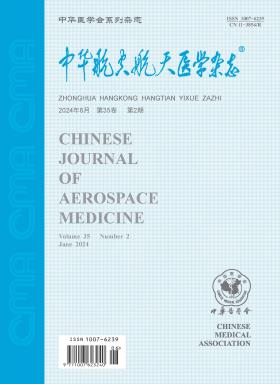On aeromedical evaluation of 16 cases of aircrews (students) with traumatic brain injury and standard discussion
引用次数: 0
Abstract
Objective To explore the aeromedical evaluation standard of the aircrews with traumatic brain injury (TBI). Methods The clinic data of 16 cases of aircrews (students) with TBI were analyzed and related literatures were reviewed. Results In 16 TBI cases, the severe took 5 cases while the moderate and the mild was 2 and 9 respectively. The medical evaluation concluded 8 qualified cases and 1 temporarily grounding. The rest 7 were disqualified. ①Four of 5 severe TBI cases had cerebral contusion: one was complicated by intracranial hematoma and he suffered post-traumatic epilepsy (PTE) by a traumatic brain injury 10 years later, one was combined with skull fracture, facial nerve and acoustic nerve damage, one was with olfactory nerve damage, and one was with epidural hematoma. The rest 1 had epidural hematoma combined with skull fracture. One case was qualified, 1 was temporarily grounding and 3 were disqualified. ②Two moderate cases had the lost consciousness experience for 30 min to 24 h. One had post-traumatic brain injury syndrome (PTBIS). One case was qualified and another one disqualified. ③Four of 9 mild cases were conscious, but 3 of them had PTBIS. Other five cases were unconsciousness within 30 min. Two of them had PTBIS and 1 had PTE. Six mild cases were qualified and another 3 were disqualified. Conclusions TBI aeromedical evaluation should be individually decided according to the severity, sequel and refer to aircraft type, duty in flight, experience and personal desire, as well as the related standards. Key words: Craniocerebral trauma; Eligibility determination; Aerospace medicine; Aircrews16例外伤性脑损伤机组(学员)航空医学评价及标准探讨
目的探讨创伤性脑损伤(TBI)机组人员的航空医学评价标准。方法对16例机组(学生)TBI患者的临床资料进行分析,并复习相关文献。结果16例TBI中,重度5例,中度2例,轻度9例。医学鉴定合格8例,暂停飞1例。其余7人被取消比赛资格。①5例重型颅脑损伤患者中,4例发生脑挫伤,1例合并颅内血肿,10年后发生外伤性脑损伤后癫痫(PTE), 1例合并颅骨骨折、面神经、听神经损伤,1例合并嗅觉神经损伤,1例合并硬膜外血肿。其余1例为硬膜外血肿合并颅骨骨折。合格1例,临时停飞1例,不合格3例。②2例中度患者出现30min ~ 24h的意识丧失,1例出现创伤后脑损伤综合征(PTBIS)。一例合格,另一例不合格。③9例轻症患者中4例意识清醒,3例有PTBIS。另外5例在30min内意识不清,2例为PTBIS, 1例为PTE,轻症合格6例,不合格3例。结论颅脑损伤的航空医学评价应根据严重程度、后遗症、机型、飞行任务、经验、个人意愿及相关标准等因素单独确定。关键词:颅脑损伤;资格审定;航空航天医学;机组人员
本文章由计算机程序翻译,如有差异,请以英文原文为准。
求助全文
约1分钟内获得全文
求助全文
来源期刊

中华航空航天医学杂志
航空航天医学
自引率
0.00%
发文量
2962
期刊介绍:
The aim of Chinese Journal of Aerospace Medicine is to combine theory and practice, improve and popularize, actively advocate a hundred flowers bloom and a hundred schools of thought contend, advocate seeking truth from facts, promote the development of the related disciplines of aerospace medicine and human efficiency, and promote the exchange and penetration of aerospace medicine and human efficiency with other biomedical and engineering specialties.
Topics of interest for Chinese Journal of Aerospace Medicine include:
-The content of the journal belongs to the discipline of special medicine and military medicine, with the characteristics of multidisciplinary synthesis and cross-penetration, and mainly reflected in the aerospace industry, aerospace flight safety and efficiency, as well as the synthesis of special medicine, preventive medicine, environmental medicine, psychology, etc.
-Military aeromedicine (Air Force, Navy and Army aeromedicine) and civil aeromedicine, with a balance of aerospace medicine are the strengths of the journal.
-The change in aerospace medicine from a focus on promoting physiological compensatory adaptations to enhancing human performance under extreme environmental conditions is what the journal is helping to promote.
-The expansion of manuscripts in high altitude medicine is also a special emphasis of the journal.
 求助内容:
求助内容: 应助结果提醒方式:
应助结果提醒方式:


